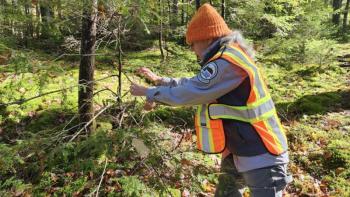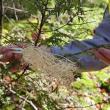Fighting bugs with bugs: How the Midcoast is defending its hemlocks
 Maine Forest Service entomologist Colleen Teerling gently places a colony of Laricobius nigrinus beetles on the tip of a hemlock branch. Photo courtesy the New England Forestry Foundation.
Maine Forest Service entomologist Colleen Teerling gently places a colony of Laricobius nigrinus beetles on the tip of a hemlock branch. Photo courtesy the New England Forestry Foundation. Though they’re proven adelgid killers, the exact success of each beetle colony is hard to judge. “It’s a black box,” Milakovsky said. “You release them. Then you really hope they’ll come back in a few years.” Photo courtesy the New England Forestry Foundation.
Though they’re proven adelgid killers, the exact success of each beetle colony is hard to judge. “It’s a black box,” Milakovsky said. “You release them. Then you really hope they’ll come back in a few years.” Photo courtesy the New England Forestry Foundation. Maine Forest Service entomologist Colleen Teerling gently places a colony of Laricobius nigrinus beetles on the tip of a hemlock branch. Photo courtesy the New England Forestry Foundation.
Maine Forest Service entomologist Colleen Teerling gently places a colony of Laricobius nigrinus beetles on the tip of a hemlock branch. Photo courtesy the New England Forestry Foundation. Though they’re proven adelgid killers, the exact success of each beetle colony is hard to judge. “It’s a black box,” Milakovsky said. “You release them. Then you really hope they’ll come back in a few years.” Photo courtesy the New England Forestry Foundation.
Though they’re proven adelgid killers, the exact success of each beetle colony is hard to judge. “It’s a black box,” Milakovsky said. “You release them. Then you really hope they’ll come back in a few years.” Photo courtesy the New England Forestry Foundation.The frontline of Maine’s battle against the invasive hemlock woolly adelgid is concentrated in the Midcoast, where the tiny insect is wreaking havoc on its namesake evergreens.
After arriving in Kittery more than two decades ago, the adelgid has traveled up Maine’s coast largely unrestricted and bypassed a state quarantine on moving hemlock saplings designed to prevent the adelgid’s spread.
Hailing from East Asia, it has no natural predators in New England. Maine’s eastern hemlock trees are largely defenseless against the swarms of adults that pitch tents of protective white fluff and siphon sap from the tree’s deep green branches until the host dies.
The adelgid has wiped out scores of hemlocks in southern Maine and is creeping further inland each year, threatening to infiltrate the state’s so-called “hemlock belt” in the western mountains, where mature sections of Maine forests are nestled in the foothills.
In recent years, however, a coalition of Midcoast land trusts, private landowners and Maine Forest Service officials have ramped up their efforts to control the hemlock woolly adelgid by recruiting the help of a familiar foe: two species of beetle that prey on the adelgid in Asia and the U.S. Pacific Northwest.
It’s a counteroffensive that forest managers hope will knock back the adelgid to both relieve the recently infested hemlocks in the Midcoast and thwart the insect’s inland expansion.
“The more we do to reduce the population of hemlock woolly adelgid in the Midcoast area will probably [determine] how fast it moves into more inland areas and our big hemlock belts,” said Colleen Teerling, the Maine Forest Service entomologist overseeing Maine’s adelgid response.
Calling reinforcements
On a chilly October morning in Wiscasset’s Sortwell Memorial Forest, the latest batch of adelgid-eating beetles arrived in clear cylindrical containers shipped overnight from a lab at Virginia Tech.
The 90-acre forest is owned and managed by the New England Forestry Foundation and has a few prominent pockets of eastern hemlock in the early stages of hemlock woolly adelgid infestation, according to Brian Milakovsky, senior forester for the nonprofit.
That timing made the forest a good candidate for treatment, Milakovsky said, and helped the organization secure 525 Laricobius nigrinus beetles for free through the U.S. Forest Service.
Scientists and U.S. forestry officials have vetted both L. nigrinus and a similar species, Laricobius osakensis, to ensure they’ll only prey on the adelgid and not cause collateral damage in eastern North America. Initial research on L. nigrinus began in the late 1990s when scientists at Virginia Tech studied the beetle’s lifecycle and feeding behaviors in a quarantined laboratory.
Then, in 2001, the U.S. Department of Agriculture stepped in and created an adelgid taskforce, approving L. nigrinus for deployment in eastern forests. Hundreds of thousands of lab-grown L. nigrinus have been released since, with a recent study showing significant success in slowing adelgid reproduction in southern and mid-Atlantic states where adelgid first arrived.
With backup in hand, Milakovsky and Teerling extracted nests of the poppy seed-sized beetles from the cylinders and gently placed each colony on low-hanging hemlock branches.
Whether the beetles are successful in hunting down the white fluffy clusters of hemlock woolly adelgid won’t be clear for another year or two. The adelgid reproduces asexually and concentrates in the upper branches by the hemlock’s crown — making it and the beetle difficult targets to measure.
“It’s a black box,” Milakovsky said. “You release them. Then you really hope they’ll come back in a few years.”
Coordinating responses
Milakovsky is trying to build on the work that he and the New England Forestry Foundation have done in Sortwell Forest and connect it to other hemlock woolly adelgid treatments elsewhere in the Midcoast.
The nonprofit owns 41,000 acres across New England and recently received a $15,000 grant from the Open Space Institute, a New York-based conservation group, to craft a management plan that addresses the adelgid and other invasives, which could lead to collaborations with other landowners.
Colonies of the predator beetles cost $250 per container without the financial support that New England Forestry Foundation received, incentivizing both Midcoast land trusts and private landowners to coordinate their purchases when possible.
Teerling, with the Maine Forest Service, organizes that response from the top-down. She answers calls from landowners, diagnoses adelgid infestations and then helps coordinate beetle releases such as the one in Wiscasset.
“These little pinpoints of releases will spread, coalesce and grow together so that we have predators throughout the region,” Teerling told The Maine Monitor. “A lot of land trusts and landowners … have bought them. So we’ve had [tens of thousands of beetles] released in the past few years.”
Brad Weigel, land steward for Damariscotta-based Coastal Rivers Conservation Trust, is contributing to that uptick.
Coastal Rivers conserves more than 7,000 acres across the Damariscotta-Pemaquid region and has expanded its effort to reduce hemlock woolly adelgid populations over the past four years. The land trust first partnered with Waldoboro to release beetles in the town forest and try to stymy the adelgids threatening a stand of towering hemlocks.
After buying about 15 beetle colonies that first year, Coastal Rivers partnered with more land trusts to buy more beetles from their Pennsylvania beetle provider, Tree Savers, taking advantage of a discount for buying colonies in bulk.
“We’ve kind of snowballed now,” Weigel said. “There’s no guarantee that this is the magic bullet, but it’s seemed to have worked, so we have faith that it will.”
In addition to the beetles, deep freezes are the best antidote against hemlock woolly adelgid. A cold snap during the winter of 2023 provided Maine hemlock trees significant respite, according to Teerling, killing back 95 to 100 percent of adelgids in some places.
“Hemlock trees look a lot better recently because of two years of good growth without hemlock woolly adelgid,” Teerling said.
That doesn’t mean they’ll stay healthy. Maine winters have warmed 5 degrees Fahrenheit over the past century due to climate change. It is the fastest warming season.
Teerling knows that Maine will never fully eradicate hemlock woolly adelgid from its vast forests, but she is optimistic about the state’s ability to knock back its population and limit hemlock casualties as mid-Atlantic states have been able to do.
“Our hope is to get as much bio-control out there as possible, so that it will help keep the population a little bit lower, so that the trees may survive,” Teerling said.
This story was originally published by The Maine Monitor, a nonprofit civic news organization. To get regular coverage from The Monitor, sign up for a free Monitor newsletter here.



























